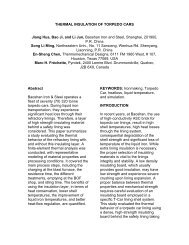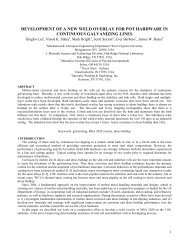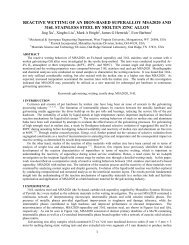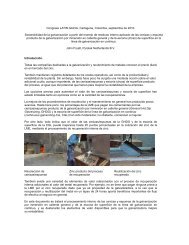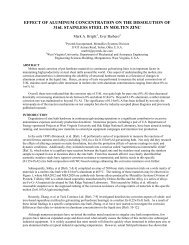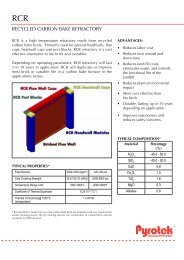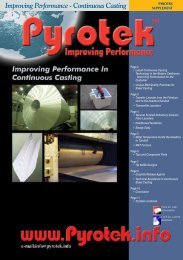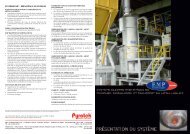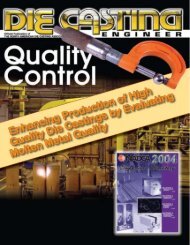The advantages of recycling metallic zinc from the ... - Pyrotek
The advantages of recycling metallic zinc from the ... - Pyrotek
The advantages of recycling metallic zinc from the ... - Pyrotek
You also want an ePaper? Increase the reach of your titles
YUMPU automatically turns print PDFs into web optimized ePapers that Google loves.
Consequently, <strong>the</strong> negative impact that has developed as a result <strong>of</strong> <strong>the</strong> depleted <strong>zinc</strong> production<br />
has been a sharp rise in primary <strong>zinc</strong> prices. Over a twelve month period <strong>from</strong> May 2005 to May<br />
2006 (Figure 3), <strong>zinc</strong> prices rose at an unprecedented pace <strong>from</strong> US$0.565/lb. to US$1.625/lb.<br />
In addition, <strong>the</strong>se LME cash prices did not reflect surcharges, delivery fees and o<strong>the</strong>r “extras”<br />
imposed by <strong>the</strong> <strong>zinc</strong> producers.<br />
LME Cash Price (US$/Tonne)<br />
$4,000<br />
$3,500<br />
$3,000<br />
$2,500<br />
$2,000<br />
$1,500<br />
$1,000<br />
$500<br />
$0<br />
January-05<br />
March-05<br />
May-05<br />
July-05<br />
September-05<br />
November-05<br />
FIGURE 3: LME Cash Price for Zinc and Hot-Dipped Galvanized Steel (HDG) [Ref. 7 & 8]<br />
Meanwhile, as <strong>the</strong> costs <strong>of</strong> <strong>zinc</strong> were rising rapidly, galvanized steel producers tried to maintain<br />
analogous price increases for <strong>the</strong> finished hot-dip galvanized sheet steel (Figure 3), however, <strong>the</strong><br />
cost differential still impacted <strong>the</strong> bottom line for many producers. “Zinc is now reported to<br />
account for 25% to 30% <strong>of</strong> <strong>the</strong> cost <strong>of</strong> HDG steel, as compared to around 5% before <strong>the</strong> price <strong>of</strong><br />
<strong>zinc</strong> headed skywards [Ref. 5].” Hence, steel companies must now start to consider alternative<br />
technologies for minimizing <strong>the</strong>ir <strong>zinc</strong> consumption such as tighter coating weight control and<br />
<strong>recycling</strong> <strong>of</strong> <strong>metallic</strong> <strong>zinc</strong> waste materials.<br />
January-06<br />
March-06<br />
Zinc Recycling<br />
Zinc, like most o<strong>the</strong>r metals, is easily recycled and approximately 30% <strong>of</strong> <strong>the</strong> overall <strong>zinc</strong><br />
consumption is currently <strong>from</strong> secondary sources [Ref. 2]. Many <strong>zinc</strong>-based products can<br />
reintroduce scrap components back into <strong>the</strong> production process with little variation. Brass scrap<br />
and <strong>zinc</strong> die castings can be directly remelted and recast as new parts much in <strong>the</strong> same manner<br />
as aluminum and iron castings. However, <strong>zinc</strong>-coated steel scrap and galvanizing process wastes<br />
are not as readily returned to <strong>the</strong> manufacturing process flow. In 1996, it was reported [Ref. 2]<br />
that <strong>the</strong> utilization <strong>of</strong> secondary <strong>zinc</strong> ingot by galvanizing facilities equated to less than 40% <strong>of</strong><br />
<strong>the</strong> tonnage <strong>of</strong> <strong>the</strong> <strong>zinc</strong> scrap, drosses, residues and wastes produced by <strong>the</strong> coating process.<br />
May-06<br />
July-06<br />
September-06<br />
Zinc<br />
HDG





